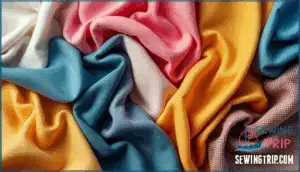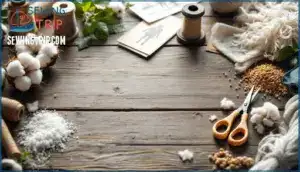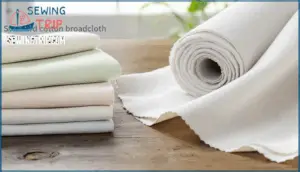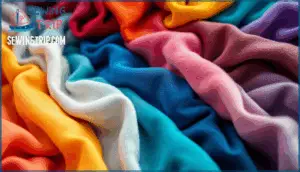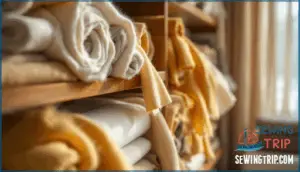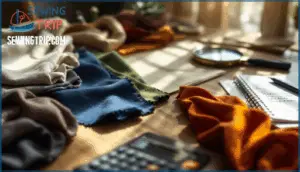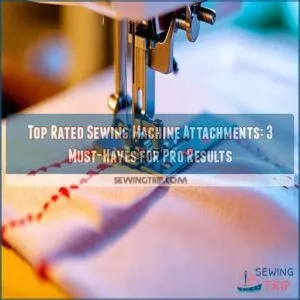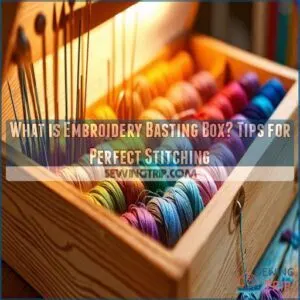This site is supported by our readers. We may earn a commission, at no cost to you, if you purchase through links.
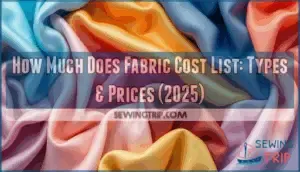 Last month, a small boutique owner in Portland messaged me in a panic—she’d budgeted $500 for fabric, only to discover that silk alone would eat up her entire budget before she’d covered a single dress. You’re not alone if fabric prices feel like a moving target.
Last month, a small boutique owner in Portland messaged me in a panic—she’d budgeted $500 for fabric, only to discover that silk alone would eat up her entire budget before she’d covered a single dress. You’re not alone if fabric prices feel like a moving target.
Cotton runs $5 to $25 per yard, while luxury materials can hit $3,000 per yard. The gap between polyester at $3 and cashmere at $100+ per yard means your project budget hinges on knowing exactly what you’re buying.
This breakdown walks you through current fabric costs across natural fibers, synthetics, and specialty materials so you can plan your purchases with confidence instead of guesswork.
Table Of Contents
Key Takeaways
- Fabric costs range dramatically from $3 per yard for basic polyester to $3,000 per yard for vicuña, meaning your material choice directly determines whether your project stays affordable or blows your budget.
- Natural fibers like cotton ($5-$25/yard) and silk ($20-$80/yard) cost significantly more than synthetics like polyester ($3-$10/yard), but material type accounts for 50-65% of final fabric costs due to raw material expenses, energy use, and manufacturing processes.
- Wholesale purchasing cuts fabric costs by 40-60% compared to retail because you skip store markups, and buying during off-season sales or clearance events can save another 20-40% on top of that.
- Beyond the sticker price, hidden factors like quality-driven durability (premium fabrics last 40% longer), seasonal demand fluctuations (wool peaks September-January), and manufacturing overhead (energy costs consume 25-30% of production budgets) all impact what you’ll actually pay per yard.
Fabric Cost Overview
Fabric prices can feel like wandering through a maze, with costs ranging from a few dollars to thousands per yard. Your choice of material—whether it’s everyday cotton, budget-friendly polyester, or luxurious vicuña—dramatically affects what you’ll pay.
Let’s break down the main categories so you know what to expect before you shop.
Natural Fiber Costs
When shopping for natural fibers, cotton generally runs $5 to $25 per yard, while silk pricing sits at $20 to $80 per yard. Organic cotton costs more due to sustainable farming practices. Wool variations shift based on fineness—fine Australian wool averaged around $9.71 per kilogram in early 2025. Linen costs track closely with premium natural fiber costs, and the hemp market reached nearly $4,000 per metric ton by mid-2025. Cotton prices fluctuate based on global supply and demand.
These fabric prices reflect quality, origin, and growing demand for natural textiles.
Synthetic Fiber Costs
Synthetic fibers like polyester, nylon, and acrylic offer budget-friendly alternatives to natural materials. Polyester pricing averaged around $3 to $10 per yard in 2025, with global prices reaching roughly $1,314 per metric ton in March. Nylon variants cost more—generally $2.50 to $4 per kilogram for standard grades—while acrylic advantages include lower costs at $1.70 to $2.50 per kilogram.
The synthetic fibers market is experiencing significant market growth, projected to reach $153.69 billion in 2029. Key factors include:
- Feedstock influence from crude oil prices
- Market demand driving 3.8% annual growth
- Energy costs affecting 20-25% of production expenses
You’ll find synthetic fabric price points remain stable and accessible.
Specialty Fabric Costs
Specialty fabrics serve demanding applications across automotive, construction, and healthcare sectors. High-end fabric materials like flame-retardant or antimicrobial-treated textiles cost $75 to $95 per yard, while performance fabrics with UV protection range from $18 to $20 per kilogram.
Market growth is driving these luxury fabric prices higher—specialty fabric costs reflect raw materials (50–65% of expenses) and environmental compliance.
Application trends show automotive interiors alone account for 28% of demand, with future outlook pointing toward 14% annual growth in smart textiles.
Fabric Cost List
Here’s what you’ll pay per yard for the most common fabric types and prices in 2025:
- Cotton — $5 to $25 per yard, with Egyptian and organic varieties reaching $30. It’s a solid baseline for fabric price ranges.
- Polyester — $2 to $6 per yard. Wholesale fabric prices drop even lower for bulk orders.
- Silk — $15 to $120 per yard, depending on origin and finish. Luxury fabric costs climb fast here.
- Linen — $6 to $23 per yard. Sustainable fabrics cost more upfront, but linen’s cost per wear over five years averages just $0.77.
- Wool — $35 to $70 per yard for standard grades; specialty blends like cashmere start at $30 and reach $150.
Understanding this fabric cost list helps you budget smarter and compare price per yard across different fabric types.
Factors Affecting Fabric Prices
When you’re shopping for fabric, the price tag isn’t random—it’s shaped by several key factors that work together to determine what you’ll pay. Understanding these influences helps you make smarter buying decisions and find the best value for your project.
Let’s look at what drives fabric costs up or down.
Material Type
Material type is the biggest factor in determining what you’ll pay for fabric. Natural fibers like cotton typically range from ₹415 to ₹1,330 per meter, while silk varies widely, from $8 to $110 per yard, depending on the variety. Synthetic blends, such as polyester, remain affordable at ₹83 to ₹166 per meter, making them a popular choice for mass production. Regenerated fabrics like Tencel cost between ₹249 and ₹581 per meter, and luxury materials like cashmere can reach up to ₹8,300 per meter. Technical textiles, with their specialized performance features, often command even higher prices.
| Fabric Types | Fabric Cost Range |
|---|---|
| Natural Fibers | ₹415–₹8,300/meter |
| Synthetic Blends | ₹83–₹250/meter |
| Regenerated Fabrics | ₹166–₹581/meter |
| Luxury Materials | ₹3,000–₹8,300/meter |
Quality and Durability
Fiber composition and weaving integrity are the backbone of material quality and durability. High-quality fabrics with long-staple cotton or fine wool cost 20–60% more but last considerably longer—premium materials can extend garment lifespan by 40%. Finishing impact matters too; processes like mercerization boost tensile strength by 15%.
Durability testing using methods like Martindale abrasion tests helps verify performance, with fabrics exceeding 30,000 rubs.
Sustainable performance fabrics made from recycled synthetics match virgin materials in strength while cutting energy use by 30%, proving material longevity doesn’t have to sacrifice environmental responsibility.
Manufacturing Process
In textile production, material costs directly determine up to 65% of final fabric prices. Energy costs significantly affect the bottom line—weaving and heat-setting alone consume 25–30% of operational budgets, while polyester production uses roughly 482 MJ per kilogram. Here’s how manufacturing process elements shape what you pay:
- Energy Costs: Weaving and finishing stages drive 25–30% of expenses; European mills face 80% higher energy bills post-2022.
- Labor Costs: Manual operations account for 20–30% of production costs; automation cuts labor expenses by 15–25% per meter.
- Raw Materials: Yarn and fiber inputs represent 50–65% of total costs; polyester feedstock jumped 9.5% year-over-year to $2.30/kg.
- Process Efficiency: Dyeing and finishing add 20–25% to greige fabric costs; wastage and shrinkage consume another 7%.
- Automation Tech: Smart looms reduce power use by 12–15% and lower per-meter costs by $0.10–0.15 in high-volume operations.
Direct production generally runs $5.00 per meter before overhead—add another 20% for indirect costs. The textile industry increasingly relies on predictive maintenance and digital systems to cut unscheduled downtime by 40%, stabilizing prices while improving fabric production output.
Market Demand
Market demand shapes fabric prices like a tide—when demand surges for apparel or technical textiles, prices rise fast. Apparel accounts for 72.9% of textile market revenue, while consumer spending on clothing averages $162 monthly per U.S. household. Regional consumption also matters: Asia-Pacific drives over 50% of global demand, and sustainability impact is growing at 9.5% annually.
Here’s how demand drivers move the needle:
- Consumer behavior: Online fashion sales jumped 18% year-over-year, accelerating fabric orders and tightening supply chains.
- Industrial textiles: Technical fabrics for automotive and healthcare expand at 8.3% CAGR, competing for production capacity.
- Price elasticity: When cotton fiber prices climbed to $2,160 per metric ton in Q2 2025, buyers shifted toward synthetic alternatives.
Fabric trends and prices reflect real-time market demand—watch seasonal peaks and regional consumption shifts to time your purchases smartly.
Fabric Type Price Comparison
When you’re shopping for fabric, price differences can feel like a maze. Different materials carry vastly different price tags, from budget-friendly synthetics to ultra-luxury fibers that cost more than a month’s rent.
Let’s break down what you’ll pay for cotton, synthetic, and luxury fabrics so you know exactly what to expect.
Cotton Fabric Cost
Cotton runs between $5 and $25 per yard, but that range tells only part of the story. In 2025, standard cotton broadcloth costs $5 to $10 per yard, while organic cotton pushes $12 to $25. Cotton blends sit around $11.69 per yard.
The weave impacts your bottom line—canvas runs $10 to $20, muslin stays under $10. Print pricing adds another layer, with designer quilting cotton reaching $15 per yard.
Global trends show cotton averaging 64.40 cents per pound in mid-2025, down from previous years, which affects fabric prices across the board.
| Cotton Type | Price Per Yard | Best For |
|---|---|---|
| Broadcloth | $5–$10 | Everyday projects |
| Organic Cotton | $12–$25 | Sustainable goods |
| Cotton Canvas | $10–$20 | Heavy-duty items |
Synthetic Fabric Price
Synthetic fabrics deliver affordability that natural fibers can’t match. Polyester runs $2 to $30 per yard, with plain weave at $2–$5 and designer versions reaching $15–$30. Nylon sits between $6 and $10 per yard, while acrylic ranges from $4 to $25. Rayon and viscose cost $8 to $30, depending on finish. Spandex blends run $5 to $20 per yard, with polyester-spandex mixes averaging $8–$18.
| Synthetic Fabric | Price Per Yard | Market Notes |
|---|---|---|
| Polyester | $2–$30 | Market valued at $135.6B in 2025 |
| Nylon | $6–$10 | 8% demand increase in 2025 |
| Acrylic | $4–$25 | 20–30% cheaper than wool |
| Rayon/Viscose | $8–$30 | 12% higher global demand |
| Spandex Blends | $5–$20 | 29% demand spike mid-2025 |
Luxury Fabric Price
While synthetics offer affordability, luxury fabrics command premium prices that reflect their rarity and craftsmanship. The luxury fabrics market reached $3.24 billion in 2025, growing at 10.5% annually as demand for exclusive materials surged. Exotic fiber costs lead the pack—vicuña runs $1,800 to $3,000 per yard, while guanaco fibers cost $400 per kilogram. Cashmere ranges from $300 to $500 per yard, with designer brand pricing pushing premium pieces beyond $2,400.
| Luxury Fabric | Price Per Yard | Market Factor |
|---|---|---|
| Vicuña | $1,800–$3,000+ | Rarest natural fiber |
| Cashmere/Pashmina | $300–$500 | 28% price increase since 2022 |
| Premium Silk Blends | $70–$300 | Sustainable luxury demand |
Regional price trends show Asia-Pacific accounting for 37% of luxury consumption, with 15% annual growth in 2025. European mills raised fabric prices 8–12% yearly as production costs climbed. Market growth factors include rising demand for sustainable luxury materials and custom tailoring, making fabric cost analysis essential for smart purchasing decisions.
Wholesale Fabric Pricing Guide
Buying fabric wholesale can feel like unlocking a secret price advantage—but you need to know how the numbers actually work. The difference between wholesale and retail pricing isn’t always what you’d expect, and knowing how to calculate costs properly can save you serious money.
Let’s break down the pricing structures, calculation methods, budget-friendly strategies, and seasonal shifts that affect what you’ll pay.
Wholesale Vs Retail Pricing
Why do wholesale fabric prices run 40–60% lower than retail pricing? It’s all about bulk purchases and price transparency. When you buy wholesale, you skip the retail markup percentages that stores add to cover advertising, rent, and operations. Wholesale-to-retail ratios usually land between 1:2 and 1:2.5.
Here’s what you gain buying wholesale:
- Bulk discounts that greatly reduce per-yard costs
- Lower markup percentages since you’re cutting out the middleman
- Direct pricing from suppliers without retail overhead
- Seasonal sales opportunities at distributor level
Retail pricing includes those extra costs—which is why the same cotton might run $4–$8 wholesale but $10–$18 retail per yard. Online parity rules sometimes limit discounts, but wholesale still delivers better value for larger orders.
Cost Calculation Methods
You’re paying more than material—calculating fabric costs means adding raw material costs, processing cost, overhead analysis, wastage reduction, and profit margins. Raw materials claim 50–60% of the total, while processing and overheads split another 35–50%. Wastage generally runs 2–5%, and profit margins land between 5–20%. Fabric cost calculation uses this formula: Raw Material + Processing + Overheads + Wastage + Profit.
Factors affecting fabric prices include yarn count, GSM, and finishing treatments.
Budget Friendly Fabric Options
Smart shopping starts with knowing where to look. You can stretch your budget by targeting discount outlets and clearance sales, where prices drop 40–60% below retail. Recycled fabrics like polyester cost $3–$10 per yard, while blended textiles balance quality and savings at $3–$15 per yard.
Here are five budget-friendly fabric options:
- Buy wholesale directly from mills to cut costs 15–40%
- Shop cheap fabric online for competitive fabric prices
- Choose cotton muslin under $10 per yard for DIY projects
- Compare average cost of fabric across multiple suppliers
- Stock up during off-season sales for maximum savings
Seasonal Variations in Prices
Fabric costs shift with the calendar, influenced by seasonal trends and demand cycles. For instance, wool prices peak from September through January, while linen experiences a surge in July and August. Cotton prices generally soften in Q3 after the harvest, often dipping below 65 cents per pound, as seen in October 2025.
Climate impacts and production shifts also play a significant role in fabric pricing. Polyester prices rose by 9.5% in 2025 due to increased feedstock costs. Regional differences further complicate the market, with Asian markets experiencing monsoon-related surges in fabric costs.
Discount timing is key for retailers and consumers alike. January and July sales typically offer price cuts of roughly 20% across retail markets, providing opportunities for cost savings during these periods.
Frequently Asked Questions (FAQs)
How much does a fabric cost?
You’ll spend anywhere from $3 to $100+ per yard for most fabrics. Cotton runs $5-$25, polyester sits at $3-$10, and silk ranges $20-$ Luxury options like cashmere can hit $2,400 per yard, while specialty fabrics vary widely based on quality and manufacturing complexity.
How do you calculate fabric cost?
You’ll need to add up material costs, processing expenses, labor charges, and overhead—then apply your markup strategy.
Raw materials usually make up 30-50% of the total, so start there and factor in volume discounts for larger orders.
How much does fabric cost at Walmart?
At Walmart, you’ll find prices ranging from about $3 to $60 per yard.
Natural fibers like cotton start around $18 and reach $16 per yard, while synthetic fabrics cost between $18 and $89 per yard, with most options under $
How much does luxury fabric cost?
Luxury fabrics command premium prices due to fabric rarity and artisanal processes. Vicuña, the most expensive fabric, costs $1,800 to $3,000 per yard. Mulberry silk ranges from $8 to $189 per yard, while cashmere reaches $100 to $2,400 per yard.
Ethical sourcing and brand prestige drive these prices higher.
How much does fabric cost per meter?
Fabric cost per meter ranges from $4 to $120, depending on the material and quality.
Affordable meter options like polyester start around $6, while luxury meter pricing for silk or wool can exceed $60 per meter.
How much does 2 yards of fabric cost?
You’ll spend anywhere from $4 to $60 for two yards, depending on what you’re buying.
Cotton runs $4 to $30, while synthetics like polyester stay budget-friendly at $4 to $40.
Wool and silk push higher—$30 to $60 and $24 to $100 respectively—making fabric affordability a real consideration for project budgeting.
What is the average price of fabric?
You’ll usually spend between $5 and $25 per yard for most fabrics, though market variations push luxury options like silk or cashmere well past $
Cotton averages around $10, while polyester stays closer to $5—knowing these price per yard benchmarks helps with budgeting tips and understanding fabric pricing guide essentials.
How much is 1 yard of fabric?
You’ll pay anywhere from $3 to $110 per yard depending on what you’re buying. Polyester and basic cotton sit at the budget-friendly end—around $5 to $15 per yard—while silk, wool, and specialty fabrics climb higher, often reaching $30 to $50 or more.
What is the fabric price?
You’ll encounter a wide price range when shopping for fabric. Expect to spend anywhere from $3 to $3,000 per yard, with fabric costs influenced by market volatility, ethical sourcing practices, and material type.
Price transparency varies across suppliers, affecting consumer perception and your budget.
Which fabric is costly?
When you’re chasing rarity, the rarest fibers command jaw-dropping fabric prices. Vicuña tops the luxury fabrics list at $1,800 to $3,000 per yard—only 10,000 animals exist, yielding just 5 kg annually.
Vicuña fabric commands $1,800 to $3,000 per yard, making it the world’s rarest and most expensive textile with only 10,000 animals producing just half a kilogram annually
Cashmere and mulberry silk follow, with investment potential tied to limited production volume and ethical implications of sourcing.
Conclusion
The most expensive fabric won’t save a poorly planned project, but knowing your costs beforehand can. Your how much does fabric cost list becomes a roadmap when you’re choosing between materials—$8 cotton versus $150 cashmere changes everything from your timeline to your final product.
Bookmark current prices, compare suppliers, and factor in hidden costs like shipping before you commit. Smart fabric buyers don’t chase the cheapest option; they match material costs to project goals and walk away confident they’ve spent wisely, not impulsively.
- https://industrytoday.co.uk/engineering/global-textile-market-outlook-2025-2035-poised-for-steady-growth-at-29-cagr
- https://bestcolorfulsocks.com/blogs/news/textile-price-statistics
- https://fred.stlouisfed.org/series/WPU034203
- https://www.cso.ie/en/releasesandpublications/ep/p-wpi/wholesalepriceindexapril2025/
- https://www.linkedin.com/pulse/cotton-fiber-price-trend-analysis-pricing-forecast-market-vinod-kumar-u0yqc

